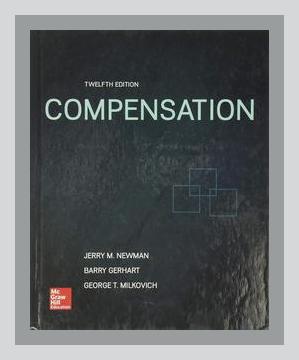Human Resources and Talent ManagementCompensation and Benefits
**
“Compensation” by George T. Milkovich and Jerry M. Newman is a seminal work in the field of compensation and benefits, providing a comprehensive overview of how compensation systems operate, their purpose, and their effects on individuals and organizations. The book dissects various facets of compensation with a structured approach, blending theory with practical insights. Below is a structured summary of the book with examples and actionable steps:
Chapter 1: Defining Compensation
Main Point: Compensation encompasses more than just pay; it includes all rewards received by employees due to their employment.
– Action Step: Consider both direct (e.g., salary, bonuses) and indirect (e.g., health insurance, retirement plans) components of compensation when designing an employee compensation package.
Chapter 2: Strategy: The Totality of Decisions
Main Point: A strategic approach to compensation aligns with organizational goals.
– Example: A tech start-up might focus on flexible benefits to attract millennial talent.
– Action Step: Conduct a thorough analysis of company goals and match the compensation strategy to support business objectives. For instance, if innovation is a priority, include profit-sharing to motivate employees to contribute ideas.
Chapter 3: Defining Internal Alignment
Main Point: Internal alignment ensures pay equity among employees and leads to employee satisfaction.
– Example: A manufacturing company structures pay differences between entry-level workers and supervisors based on job complexity.
– Action Step: Implement job analyses to classify and rank positions, ensuring fair compensation across similar levels of responsibility and skill.
Chapter 4: External Competitiveness
Main Point: Understanding the external market is vital to maintaining competitive salary structures.
– Example: A retail chain benchmarks its salaries against regional competitors to attract talent.
– Action Step: Regularly conduct market salary surveys to ensure your company remains competitive. Adjust compensation packages based on findings to retain top talent.
Chapter 5: Employee Contributions
Main Point: Contributions-based pay systems, such as merit pay or incentive plans, can directly influence employee performance.
– Example: A sales team is given bonuses based on meeting quarterly sales targets.
– Action Step: Implement performance metrics and criteria that are transparent and achievable, linking pay increases or bonuses to measurable performance.
Chapter 6: Managing Labor Costs
Main Point: Effectively managing labor costs without sacrificing quality or morale is crucial for financial health.
– Example: Lean manufacturing practices help reduce overtime costs.
– Action Step: Optimize workforce scheduling and use part-time or contingent labor during peak periods.
Chapter 7: Compensation and the Law
Main Point: Compliance with legal standards is non-negotiable.
– Example: Following the Fair Labor Standards Act (FLSA) for overtime pay.
– Action Step: Stay updated on relevant labor laws and ensure your compensation practices meet legal requirements. Engage with legal counsel for compliance reviews.
Chapter 8: Pay-for-Performance Plans
Main Point: Effectively designed pay-for-performance plans drive individual and organizational performance.
– Example: Google uses OKRs (Objectives and Key Results) to determine bonuses.
– Action Step: Develop clear performance goals aligned with organizational objectives, and ensure these are communicated effectively.
Chapter 9: Performance Appraisals
Main Point: Fair and accurate performance appraisals are essential for effective pay-for-performance.
– Example: 360-degree feedback provides comprehensive performance insights.
– Action Step: Implement multi-source feedback systems, ensuring that appraisals are objective, structured, and transparent.
Chapter 10: The Role of Benefits
Main Point: Benefits form a crucial part of the total compensation package.
– Example: Health coverage, retirement plans, and child care support are valued by employees.
– Action Step: Conduct employee surveys to determine the most valued benefits and periodically review and adjust benefit offerings.
Chapter 11: Compensation for Special Groups
Main Point: Specific groups (e.g., executives, sales, contingent workers) may require tailored compensation strategies.
– Example: Stock options for executives or sales incentives for salespersons.
– Action Step: Design compensation packages that reflect the unique contributions and financial impact of special groups within the organization.
Chapter 12: Compensation Metrics
Main Point: Using metrics to evaluate the effectiveness of compensation strategies ensures they are contributing to organizational goals.
– Example: Tracking turnover rates and employee satisfaction scores after a pay adjustment.
– Action Step: Develop a set of key performance indicators (KPIs) related to compensation to monitor and adjust strategies as needed.
Examples and Recommendations
- Example 1: Adoption of a Balanced Scorecard approach links compensation to multiple performance measures, ensuring a holistic evaluation of employee performance.
-
Action Step: Customize a Balanced Scorecard for your organization, incorporating financial, customer, internal process, and learning & growth metrics.
-
Example 2: Use of benefit differentiation to cater to a diverse workforce.
-
Action Step: Offer a cafeteria benefits plan where employees can choose from a menu of benefits to match their needs.
-
Example 3: Innovative compensation trends such as remote work allowances.
- Action Step: Evaluate and possibly include remote work stipends as part of the compensation package.
Conclusion
“Compensation” by Milkovich and Newman offers a detailed exploration of how compensation systems can be designed and managed to support strategic business objectives. From foundational concepts to practical implementation, the book provides a thorough understanding of compensation’s role in talent management and organizational success. Adopting its principles and practices through concrete actions not only ensures fair and competitive compensation practices but also aligns them with wider business goals.
By breaking down each chapter with relevant examples and actionable steps, this summary provides a comprehensive yet practical guide to leveraging compensation as a strategic advantage.
Human Resources and Talent ManagementCompensation and Benefits
